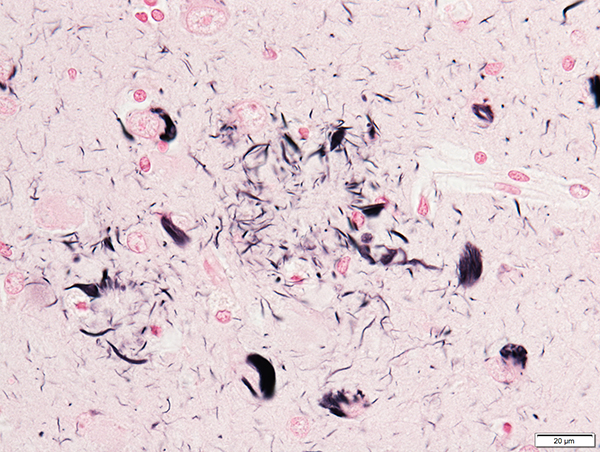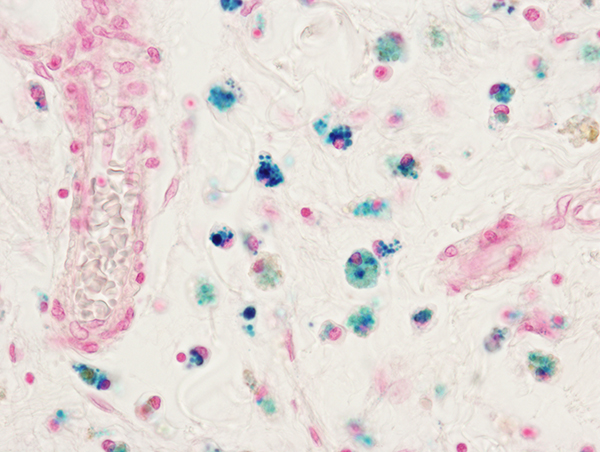⑫ Staining
Nuclear staining used in the neuropathology laboratory
Nuclear staining has been used as a counterstain. Usually, it is used in combination with primary staining methods such as immunostaining, Gallyas-Braak staining, Berlin blue staining, and Kossa staining. By combining the nuclear staining, the localization of pathological structures detected by the primary staining methods can be easily identified. What is important in combination is that the nuclear dye does not interfere with the primary one.
1.Immunostaining & hematoxylin
Aggregation of phosphorylated tau is detected in brown color. The nucleus is detected blue color by hematoxylin.

2.Gallyas-braak staining & kernechtrot (nuclear fast red)
Dystrophic neurites surrounding senile plaques, neurofibrillary tangles in the cell body of neurons and neuropil threads are detected in black color. The nucleus is detected in red color by kernechtrot.

3.Berlin-blue staining & kernechtrot (nuclear fast red)
Hemosiderin-laden macrophages are detected in blue color. The nucleus is detected in red color by kernechtrot.

Nuclear staining by hematoxylin
Meyer’s hematoxylin solution
- It is the same as the solution used in HE staining.
Staining procedure
| 1 | Finishing immunostaining | ||
|---|---|---|---|
| 2 | Washing | Running tap water | |
| 3 | Rinsing | Distilled water | |
| 4 | Counterstaining | hematoxylin solution | 1min |
| 5 | Washing | Running tap water | 15 minutes |
| 6 | Dehydration | 95% ethanol | 5 minutes |
| 7 | Dehydration | 100% ethanol | 3changes, 5 minutes each |
| 8 | Clearing | Xylene | 3changes, 10minutes each |
| 9 | Coverslipping |
Nuclear staining by kernechtrot (nuclear fast red dye)
Kernechtrot solution
- 5% Aluminum sulfate solution 500ml
- Kernechtrot 0.5g
※ Adjust the 5% aluminum sulfate solution first, then add kernechtrot. Boil for about 5 minutes. Filter after cooling. This solution is not suitable for long-term storage. Use it as soon as you make it.
Staining procedure
| 1 | Finishing gallyas-braak staining | ||
|---|---|---|---|
| 2 | Washing | Running tap water | |
| 3 | Rinsing | Distilled water | |
| 4 | Counterstaining | Kernechtrot solution | 1 to 5 minutes |
| 5 | Washing | Running tap water | 10 minutes |
| 6 | Dehydration | 95% ethanol | Quickly |
| 7 | Dehydration | 100% ethanol | 3changes, 5 minutes each |
| 8 | Clearing | Xylene | 3changes, 10minutes each |
| 9 | Coverslipping |

